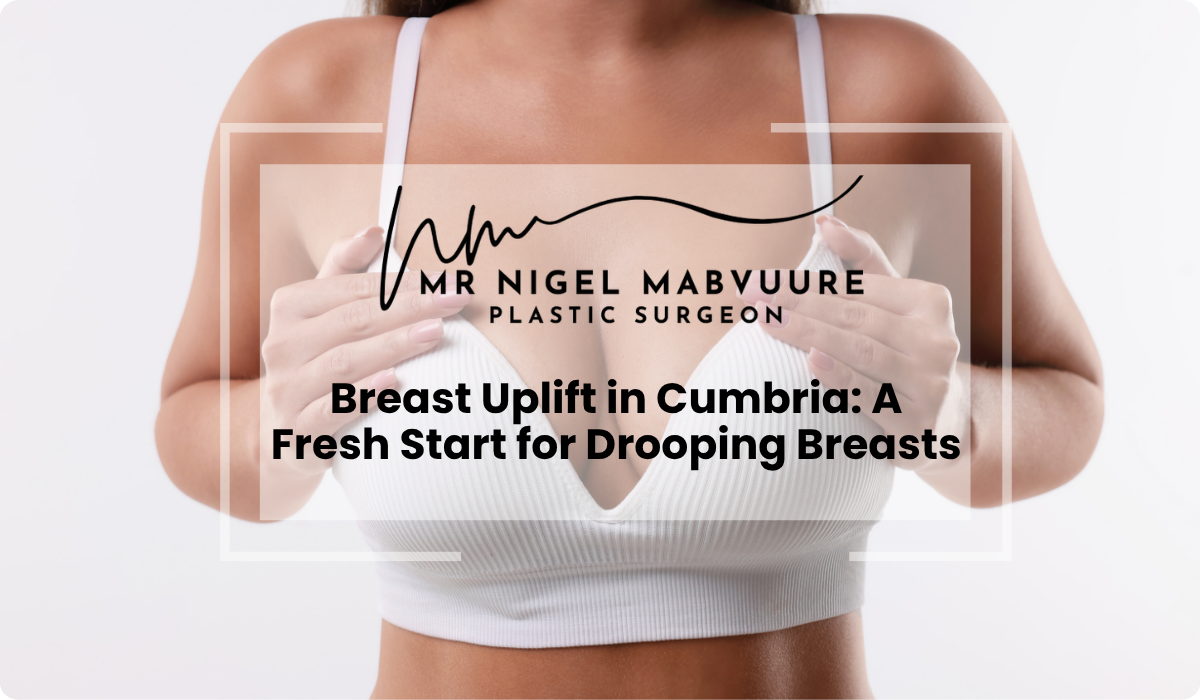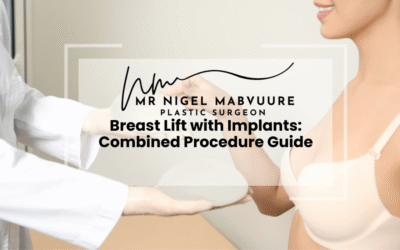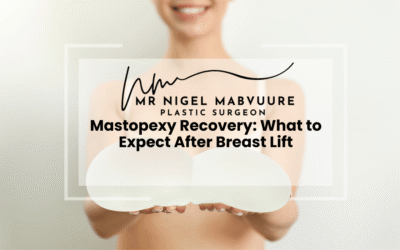Key Takeaways
- Breast ptosis (sagging) is caused by factors like aging, pregnancy, weight fluctuations, and genetics, and is classified into three grades of severity.
- A breast uplift (mastopexy) repositions existing breast tissue without adding volume, using various incision patterns depending on the degree of correction needed.
- When choosing a surgeon in Cumbria, look for GMC registration, membership in professional bodies like BAAPS or BAPRAS, and specialists with extensive breast surgery experience.
- Breast uplift results include elevated breast position, improved nipple direction, enhanced shape, and potential areola size reduction, with results typically lasting 10-15 years.
- Recovery progresses from initial discomfort and limited activity (1-3 days) to gradual return to normal activities (6-12 weeks), with final results visible after 6-12 months.
- Breast uplift addresses sagging without changing size, while augmentation increases size without significantly lifting; many patients benefit from a combined approach.
Table of Contents
- Understanding Breast Ptosis: Causes and Signs of Drooping
- Breast Uplift Surgery: What the Procedure Involves
- Finding the Best Breast Uplift Surgeons in Cumbria
- What Results Can You Expect from a Breast Uplift?
- Recovery Timeline: Healing After Your Breast Uplift
- Breast Uplift vs. Breast Augmentation: Which is Right for You?
- How Much Does a Breast Uplift Cost in Cumbria?
- Am I a Good Candidate for Breast Uplift Surgery?
Understanding Breast Ptosis: Causes and Signs of Drooping
Breast ptosis, commonly known as drooping or sagging breasts, is a natural condition that affects many women throughout their lives. The condition occurs when breast tissue loses its elasticity and firmness, causing the breasts to hang lower on the chest and the nipples to point downward rather than forward.
Several factors contribute to breast ptosis, with the most common being:
- Ageing: As we age, skin elasticity naturally decreases, and the ligaments that support breast tissue weaken.
- Pregnancy and breastfeeding: Drooping breasts after pregnancy are common as the breasts enlarge during pregnancy and milk production, then reduce in size afterward, often leaving excess skin.
- Weight fluctuations: Significant weight gain followed by weight loss can stretch the skin and supporting tissues of the breasts.
- Genetics: Some women are genetically predisposed to have less elastic skin or weaker supporting tissues.
- Gravity: The constant pull of gravity over time contributes to sagging, particularly in larger breasts.
Medical professionals classify breast ptosis into three grades:
- Grade I (Mild): The nipple is at the level of the inframammary fold (the crease beneath the breast).
- Grade II (Moderate): The nipple falls below the inframammary fold but remains above the lower contour of the breast.
- Grade III (Severe): The nipple points downward and sits below the inframammary fold, at the lowest part of the breast.
Recognising these signs can help determine if a breast uplift might be beneficial for restoring a more youthful breast position and contour.
Breast Uplift Surgery: What the Procedure Involves
A breast uplift, or mastopexy, is a surgical procedure designed to raise and reshape sagging breasts, creating a more youthful and aesthetically pleasing appearance. This procedure is ideal for those seeking a breast lift without implants, focusing solely on repositioning existing breast tissue rather than increasing volume.
The surgery typically follows these steps:
- Consultation and planning: Your surgeon will assess your breast shape, size, and degree of ptosis to determine the most appropriate technique.
- Anaesthesia: The procedure is performed under general anaesthesia to ensure comfort throughout.
- Incision patterns: Depending on the degree of ptosis and desired outcome, the surgeon may use one of several incision patterns:
- Periareolar (around the areola only)
- Vertical or “lollipop” (around the areola and vertically down to the breast crease)
- Inverted-T or “anchor” (around the areola, vertically down, and horizontally along the breast crease)
- Tissue reshaping: The underlying breast tissue is lifted and reshaped to improve contour and firmness.
- Nipple repositioning: The nipple and areola are moved to a higher position to match the new breast shape.
- Excess skin removal: Surplus skin is removed to compensate for lost elasticity.
- Closure: Incisions are carefully closed with sutures, often layered within the breast tissue to support the new shape.
The procedure typically takes 2-3 hours to complete, depending on the complexity of the case. Most patients can return home the same day, though some may require an overnight stay for monitoring.
Modern techniques focus on minimising scarring while maximising results, with surgeons carefully placing incisions where they can be concealed by bra lines or natural breast contours. The breast uplift procedure can be performed as a standalone surgery or combined with breast augmentation for those who desire both lift and increased volume.
Finding the Best Breast Uplift Surgeons in Cumbria
When considering a breast uplift in Cumbria, selecting the right surgeon is perhaps the most crucial decision you’ll make. The quality of your results and safety during the procedure largely depend on the expertise and experience of your chosen specialist.
To find the best mastopexy surgeons near me in Cumbria, consider these essential factors:
- Qualifications and certification: Look for surgeons who are registered with the General Medical Council (GMC) and are members of professional bodies such as the British Association of Aesthetic Plastic Surgeons (BAAPS) or the British Association of Plastic, Reconstructive and Aesthetic Surgeons (BAPRAS).
- Specialisation in breast surgery: Ideally, your surgeon should specialise in breast procedures and perform breast uplifts regularly, not just occasionally.
- Before and after portfolio: Review the surgeon’s breast uplift before and after photos to assess their aesthetic style and the quality of their results.
- Hospital affiliations: Check which hospitals or clinics the surgeon works with, ensuring they operate in CQC-registered facilities with proper emergency protocols.
- Patient reviews: Read testimonials and reviews from previous patients to gauge satisfaction levels and the surgeon’s bedside manner.
- Consultation approach: A good surgeon will take time to understand your goals, explain the procedure thoroughly, discuss realistic expectations, and outline potential risks.
In Cumbria, you may need to consider surgeons in larger towns like Carlisle, Penrith, or Kendal, or be prepared to travel to nearby cities like Newcastle or Manchester for a wider selection of specialists. Many reputable surgeons offer initial consultations via video call before requiring in-person visits.
Remember that the cheapest option is rarely the best choice when it comes to surgical procedures. Focus on finding a surgeon whose expertise, communication style, and aesthetic vision align with your needs, even if it means travelling a bit further or investing more in your procedure.
What Results Can You Expect from a Breast Uplift?
A breast uplift can transform both the appearance of your breasts and your self-confidence. Understanding realistic expectations is essential for satisfaction with your surgical outcome.
Immediately following surgery, you’ll notice that your breasts sit higher on your chest with a more youthful contour. However, the final results will take time to develop as swelling subsides and tissues settle. Most patients can expect:
- Elevated breast position: Breasts will be repositioned higher on the chest wall, eliminating the sagging appearance.
- Improved nipple position: Nipples and areolas will point forward rather than downward, creating a more youthful appearance.
- Enhanced breast shape: The procedure reshapes the breast tissue for a more rounded, firmer contour.
- Reduced areola size: If your areolas have stretched over time, they can be reduced during the procedure.
- Symmetry improvements: Any pre-existing asymmetry can often be addressed during surgery.
It’s important to note that a breast uplift does not significantly change the size of your breasts. While they may appear fuller due to improved projection and shape, the procedure primarily addresses position and contour rather than volume.
Regarding the question of how long does a breast uplift last, results are generally long-lasting but not permanent. Natural ageing, gravity, weight fluctuations, and future pregnancies can all affect your results over time. Most women enjoy their results for 10-15 years or longer, particularly if they maintain a stable weight and healthy lifestyle.
Scarring is an inevitable aspect of breast uplift surgery. Initially, scars will appear red and raised but typically fade and flatten over 12-18 months. The extent of scarring depends on the surgical technique used, with more extensive ptosis correction requiring more extensive incisions.
For the most natural-looking results, it’s crucial to follow all post-operative care instructions and attend all follow-up appointments with your surgeon.
Recovery Timeline: Healing After Your Breast Uplift
Understanding the breast uplift recovery time is essential for planning your procedure and setting realistic expectations. While each patient’s healing journey is unique, most follow a similar timeline:
Immediate Post-Surgery (1-3 days)
- You’ll wake up wearing a surgical support bra with dressings over your incisions
- Moderate discomfort, managed with prescribed pain medication
- Possible drainage tubes (usually removed before discharge)
- Limited arm movement recommended
- You’ll need someone to drive you home and stay with you for at least 24 hours
First Week
- Significant swelling and bruising is normal
- Pain typically subsides to mild discomfort
- Limited to light activities only
- Sleep on your back with your upper body slightly elevated
- Wear your surgical support bra 24/7 as directed
- First follow-up appointment to check healing
2-4 Weeks
- Swelling and bruising begin to subside
- Stitches typically removed (if not dissolvable)
- May return to desk-based work after 1-2 weeks
- Continue wearing support bra as directed
- Gradually increase light activities
- Avoid lifting anything heavier than 2kg
4-6 Weeks
- Most swelling resolved, though some may persist
- Incision lines remain pink but begin to fade
- May transition to a sports bra (as advised by surgeon)
- Can usually resume most normal activities
- Avoid strenuous exercise, particularly upper body workouts
6-12 Weeks
- Cleared for most physical activities, including gentle exercise
- Breasts begin to settle into their final position
- Sensation continues to improve if numbness was present
- May be cleared to sleep in any position
6-12 Months
- Scars continue to fade and flatten
- Final breast shape becomes apparent as all swelling resolves
- Full sensation typically returns (though some changes may be permanent)
- Final follow-up appointments to document results
To optimise your recovery, follow all post-operative instructions carefully, attend all scheduled follow-up appointments, and contact your surgeon immediately if you experience any concerning symptoms such as increased pain, redness, warmth, or discharge from incisions.
Breast Uplift vs. Breast Augmentation: Which is Right for You?
Understanding what is the difference between breast uplift and augmentation is crucial when deciding which procedure best addresses your concerns. These surgeries serve different purposes, though they can be combined for comprehensive breast enhancement.
Breast Uplift (Mastopexy)
- Primary goal: Raises and reshapes sagging breasts without changing their size
- Addresses: Drooping position, downward-pointing nipples, stretched skin
- Does not: Significantly increase breast volume or size
- Best for: Women satisfied with their breast size but unhappy with sagging
- Procedure involves: Removing excess skin, repositioning breast tissue, and moving nipples higher
- Recovery: Generally 1-2 weeks before returning to work, 6 weeks before resuming all activities
Breast Augmentation
- Primary goal: Increases breast size and enhances shape
- Addresses: Small breast size, mild asymmetry, loss of volume after pregnancy or weight loss
- Does not: Significantly lift very droopy breasts or reposition downward-pointing nipples
- Best for: Women wanting larger breasts or to restore lost volume
- Procedure involves: Inserting implants (silicone or saline) or using fat transfer techniques
- Recovery: Similar timeline to uplift, though with different physical sensations
Combined Breast Uplift and Augmentation
- Primary goal: Addresses both sagging and size concerns simultaneously
- Addresses: Drooping, loss of volume, and desire for increased size
- Best for: Women with ptosis who also want larger breasts
- Procedure involves: Performing both techniques during the same surgery
- Recovery
Frequently Asked Questions
How long does a breast uplift last?
A breast uplift typically provides results that last 10-15 years or longer. However, the longevity depends on several factors including your age, skin elasticity, weight fluctuations, pregnancy after surgery, and lifestyle habits. While the procedure creates lasting improvements, natural aging and gravity will continue to affect your breasts over time. Maintaining stable weight and wearing supportive bras can help extend your results.
What is the difference between breast uplift and augmentation?
A breast uplift (mastopexy) raises and reshapes sagging breasts without changing their size by removing excess skin and repositioning the nipples higher. Breast augmentation increases breast size using implants or fat transfer but doesn’t significantly correct sagging. While uplift addresses position and shape, augmentation addresses volume and size. Many women choose to combine both procedures for comprehensive enhancement when they want both lifted and larger breasts.
How painful is breast uplift surgery?
Breast uplift surgery typically causes moderate discomfort rather than severe pain. Most patients describe the sensation as tightness, pressure, or soreness rather than sharp pain. The most uncomfortable period is usually the first 3-5 days, managed effectively with prescribed pain medication. By the end of the first week, most patients transition to over-the-counter pain relievers. Pain tolerance varies between individuals, but most find the recovery manageable with proper medication and rest.
Am I too old for a breast uplift?
There is no specific upper age limit for breast uplift surgery. The most important factors are your overall health and fitness for surgery rather than your chronological age. Many women in their 60s and 70s successfully undergo breast uplift procedures. Your surgeon will evaluate your medical history, current health status, and healing capacity to determine if you’re a suitable candidate. Good candidates of any age have realistic expectations, are non-smokers, and are in good physical and mental health.
Will a breast uplift reduce my cup size?
A breast uplift may result in a small reduction in cup size, typically by about one cup, due to the removal of excess skin and reshaping of the breast tissue. While the actual breast tissue volume remains largely unchanged, the improved shape and position can affect how bras fit. Many women find they need to be refitted for bras after surgery, as their previous bras were accommodating the sagging tissue. The change in size is usually minimal compared to the improvement in shape and position.
How visible are breast uplift scars?
Breast uplift scars are permanent but typically fade significantly over time. Initially, scars appear red and raised but gradually flatten and fade to thin white or silvery lines within 12-18 months. The visibility depends on the surgical technique used, your skin type, and how well you follow scar care instructions. Modern techniques place incisions in less visible locations, such as around the areola, vertically from the areola to the breast crease, and/or along the natural breast fold. Proper scar care including silicone sheets, massage, and sun protection can improve their appearance.
Can I breastfeed after having a breast uplift?
Breastfeeding after a breast uplift is possible for many women, but there is a risk that the procedure may affect milk production or delivery. The extent depends on the surgical technique used and how the nipple was repositioned. Techniques that preserve the connection between the nipple and milk ducts have higher rates of successful breastfeeding. If future breastfeeding is important to you, discuss this explicitly with your surgeon before surgery, as they can modify their approach to maximize your chances of breastfeeding successfully later.
A Complete Guide to Breast Uplift (Mastopexy)




